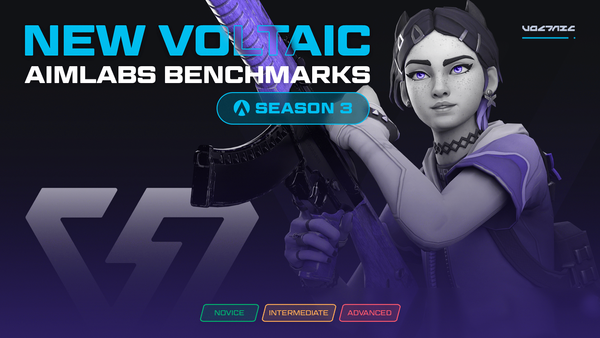Why ‘muscle memory’ is seen as a meme in aiming
Muscle memory is a topic that comes up fairly often when discussing aim training due to its frequent association with retaining and improving one’s aim. However, the term itself is rather ambiguous and mischaracterizes the process it describes.

Muscle memory is a topic that comes up fairly often when discussing aim training due to its frequent association with retaining and improving one’s aim. However, the term itself is rather ambiguous and mischaracterizes the process it describes.
As an inevitable result of the frequent discussion of this topic some rather harmful misconceptions arise, such as the idea that you have to stay on one sensitivity or you will lose/significantly-damage your ability to aim. Because of such misconceptions, members of the aim training community often prefer to use terms that more concisely and intuitively characterise the way you use a mouse while aiming. These terms include mouse control, hand eye coordination, reactivity, reading skills, smoothness et cetera.
Aim training can thus be thought of as the process of developing and refining these specific skills rather than the idea that you are simply attempting to memorise all possible movements you could make.
A large part of the reason why people believe they have to keep their sensitivity the same is due to the familiarity they have with it. This itself is a real and justified aspect of aim development but it exists far more in the short term than the other previously mentioned elements.
Consider that “The surface underneath your mouse, the mousepad, gets affected by variables such as humidity, tiny dust particles, wear, human oils and other factors. The glide and friction aren’t always the same, the feeling will not always be the same and even your positioning won’t be absolute. Due to this relativity, there is absolutely no way you could memorize how much you would need to move your mouse to perform an x-degree turn or simply aim at targets in-game.”
While playing on a given sensitivity you gain a general sense of the relationship between the motion of your mouse and your view in-game. Importantly, you are also building a dependency on the relationship between how you use the parts of your arm to achieve these motions. i.e. your dependency on the contributions of your fingers, wrist, elbow and shoulder. You can relate this to what you likely already know as “wrist” or “arm” aiming. These aspects result in the sensitivity becoming more comfortable to use as you are never surprised by the results of your input and the extent to which you need to utilize parts of your arm.
As a result people will then tend to get scared off by changing their sensitivity as they lose the familiarity it has to them, which is compounded by having to adapt to performing various types of motions with parts of their arm they aren’t used to. It is important to understand however that much like any other aspect of aim, you can develop and refine your ability to adapt to a new sensitivity. Additionally the extent to which changing your sensitivity detriments you is most pronounced when the change is drastic enough that it forces you to overhaul how you balance the use of the parts of your arm.
There is also an irrefutable wealth of anecdotal evidence within the aim training community of players changing their sensitivity constantly, even using sensitivity randomisers, all without a noticeable long term penalty to their aim. It is even often suggested to try changing your sensitivity to overcome plateaus in improvement as a new sensitivity can give you a fresh starting point to improve from.
There is also this formal research that, despite not being performed specifically in regards to the use of a computer mouse, still supports the notion of being able to adapt to changes in sensitivity.
Some may argue that holding an angle in the same position at the same level and tightness in tactical-shooters like Counter Strike or Valorant, may be more related to memory, but even in these instances there is plenty of variance, especially in both auditory and visual reaction time. That alone shows that sticking to the same sensitivity isn’t a strong enough factor.
Sure there are benefits and downsides to using a certain sensitivity, but most of it is related to comfort (so long as one doesn’t go into extremes). There is even a clip where one of the best LG duelers, Serious, who switches to extremely fast sensitivities (3cm for instance) and still beats Zexrow.
Regardless, we don’t know how much motor learning applies to aiming, but we can confidently say that changing your sensitivity isn’t harmful for practice, and very likely not harmful at all.
Also while people are really getting heated around topics like these, none of it is going to make you better at aiming. Either work on a formal research yourself, or practice, because we know that practice will make you better, not the knowledge of a few abstract definitions in aiming.
Take away points:
- The mechanisms* “muscle memory” formally refers to are very much so real, although all too often misunderstood and misinterpreted. It is because of this we avoid the term “muscle memory”.
- Changing your sensitivity doesn’t ruin your aim, it will simply require a varying amount of readjustment depending on often you change your sensitivity.
- Changing sensitivity is a fairly common training method, having both anecdotal and empirical evidence supporting it.
*Mechanisms such as Motor learning, Procedural memory, encoding and consolidation of mind muscle connections, etc.
About the Authors:
Written by sini & Tammas
Voltaic is a self-improvement community focused primarily on shooters; encompassing a Discord server with over 90.000 members and a twitter account with 40.000 followers. The Voltaic Discord server is the most prominent sector of the FPS, Aim Lab and KovaaKs resources and is responsible for a significant portion of the free resources available to the Aim training community.





